
Jacob Fox made beautiful spinning wheels. Yet, despite the fact that many fine examples of his wheels survive, I have been unable to find out very much about the man himself.

He was born Jacob Fuchs in 1788, in Berks County, Pennsylvania, son of Johann Michael Fuchs and Anna Margaretha Schwartzhaupt. Jacob’s father, Johann, was born in Hesse, Germany in 1749 and arrived in Pennsylvania as a young man in 1773. Jacob’s mother, Anna Margaretha, also of German descent, was born in Berks County in 1760.

At some point Jacob Fuchs anglicized his name to “Fox.” He married Catherine Batteiger (also spelled Potteiger) in 1815. They resided in Upper Tulpehocken Township, in Berks County, where they had several daughters, and Jacob had his workshop. Jacob died in 1862, leaving a shop that still contained his woodworking tools and branding irons. (Goyne Evans, Am. Windsor Furn. p. 222, fn. 70).
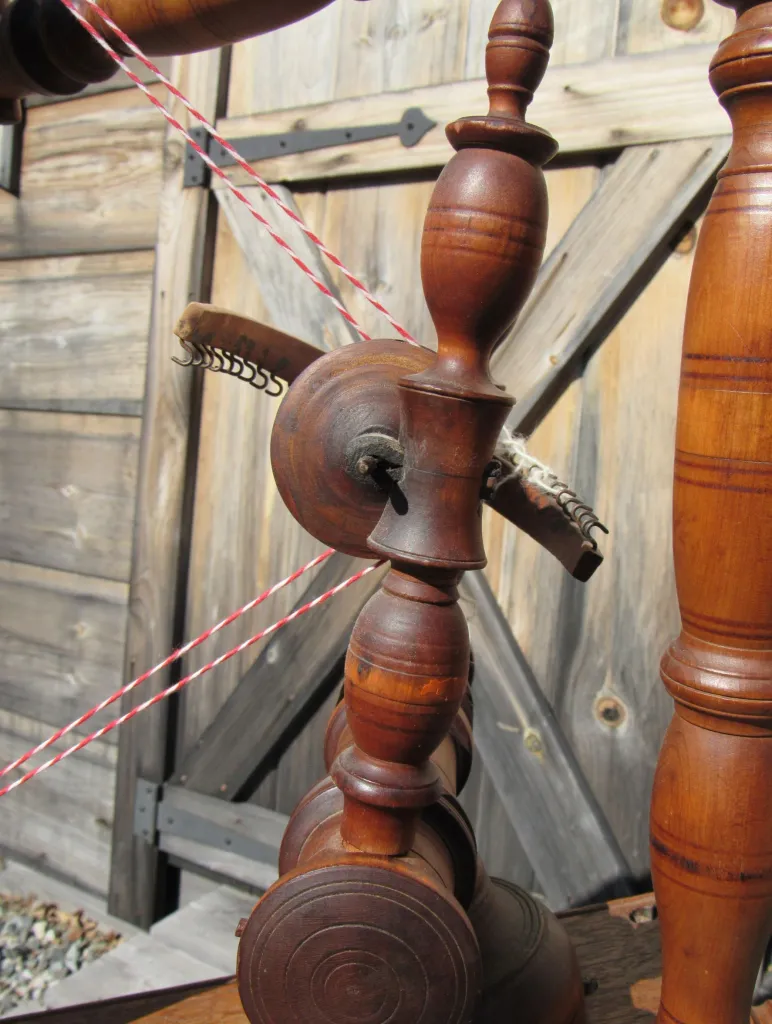
“Like many artisans of the period, Fox was both a farmer and a craftsman …” (Bartlett, pp. 28-29) He made Windsor chairs, marking them with the same brand as on my wheel, “IA: FOX.” (Goyne Evans, Am. Windsor Furn. pp. 102-03, 221).
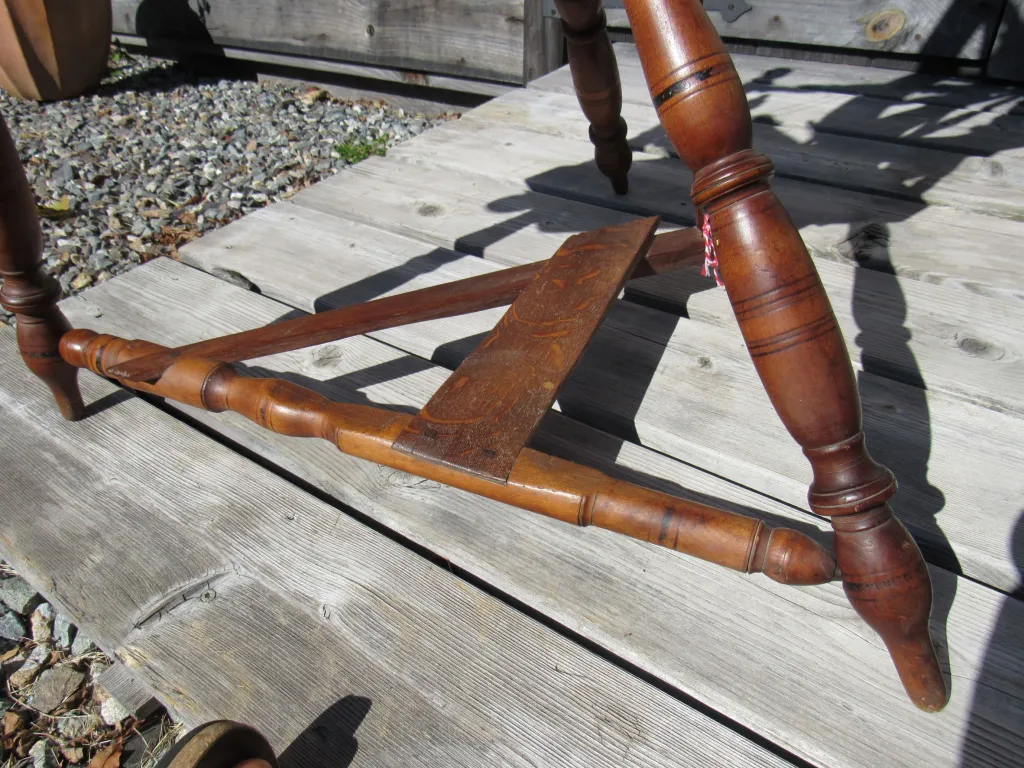
“The work of Jacob Fox in Berks County is interesting as typical of provincial interpretations of prevailing Philadelphia style, which proved popular among his local patrons. Fox made both bow-back and square-back chairs with turned work ranging from the full baluster to full bamboo style.” (Bartlett, p. 29)

In 1839, Fox had a new branding iron made, changing his mark from “IA: FOX” to “J. FOX”. Although Fox did not date his wheels, because his branding iron has a date on its side, the changed mark serves as a demarcation for wheels made before and after 1839.

Aside from this rather bare-bones “he-was-born-he-worked-he-died” life summary, I found little information to bring Jacob Fox to life. Perhaps his wheels must speak for him. We can see from them Fox’s meticulous attention to detail and quality.

From a business perspective, he appeared to have an eye for his market. As with his chair making, Fox’s wheels were made in the style popular for his time and place. His wheels share certain distinctive features with other Berks County wheels marked “D. Kunkel,” “D.S.,” “H.S.,” and “J. Jacob.” (P&T, p. 127).
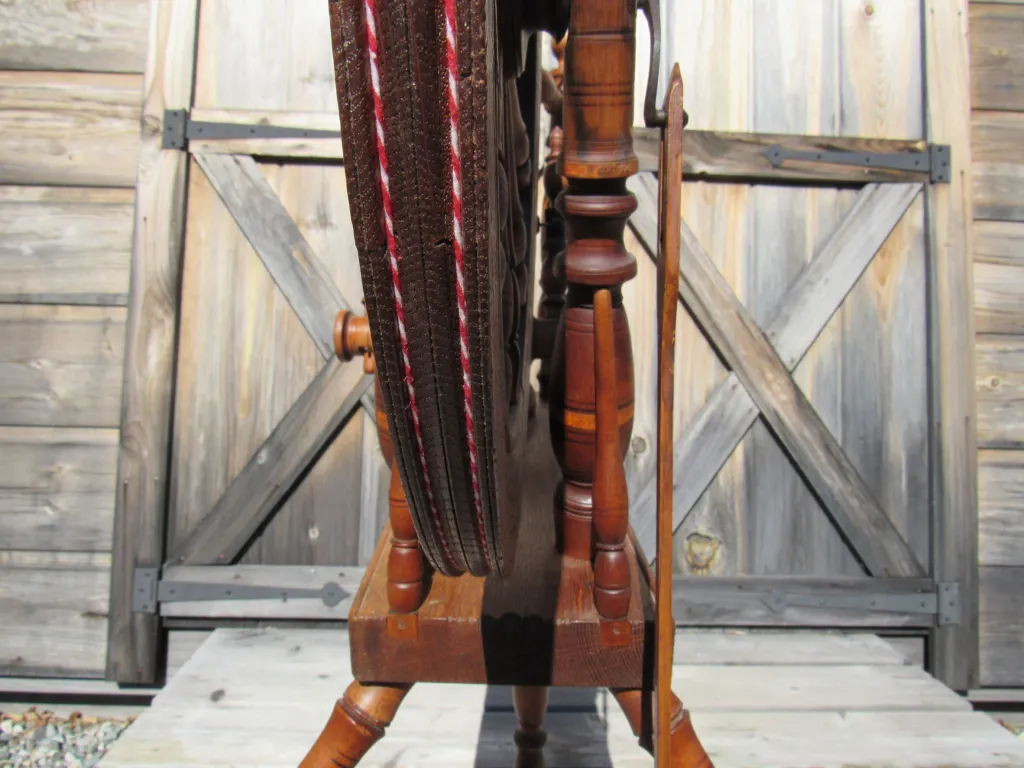
Those construction features included secondary upright supports on both sides, snugly fitted and pegged flush in the table,

and drive wheels constructed of four roughly equal sections,

each section, or felloe, tightly joined

and double pegged.
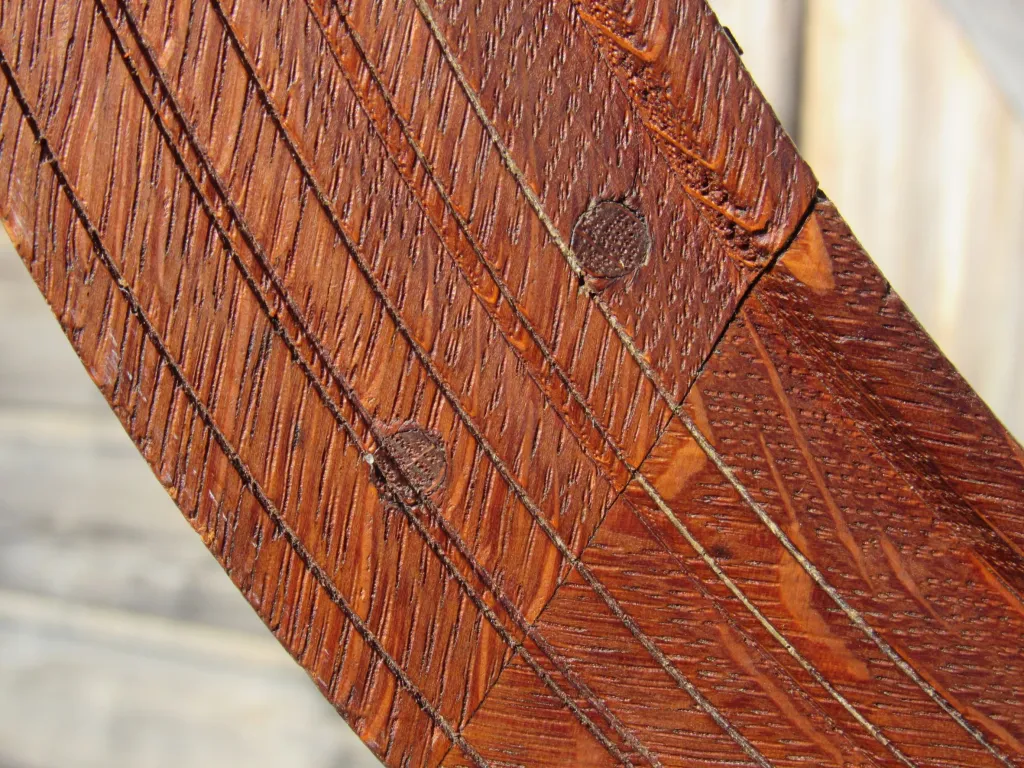
Another unusual feature, popular in eastern and central Pennsylvania, was a hole through the table’s spinner side for a reeling pin. (Taylor, SWS p.7)

Reeling pins were turned wooden pins about the size of a finger. It is believed they were used for guiding the spun thread when unwinding it from the wheel’s bobbin onto a reel. The theory is that it saved fingers from friction burn (think of rope-burn on a finer scale) and cuts made by fast-reeling flax thread. It seems like something a city women with soft hands might have used but less likely to be in high demand from farm women, whose hands likely were well-callused and work-hardened enough not to be bothered by unwinding flax.

Ester’s reeling pin is gone, but the hole is a reminder of how quickly we lose knowledge about wheel design and use at particular times and places. Why are holes for reeling pins found in only a small area of the country? Was it a tradition brought from a German region? Were reeling pins used in other parts of this country, but without storage holes? Or were they a nineteenth century local fad?

While Fox’s wheels share similarities with other area wheel makers, his wheels also have a certain flair that mark them as his creations. From hub,

to axle bearings,


to spokes
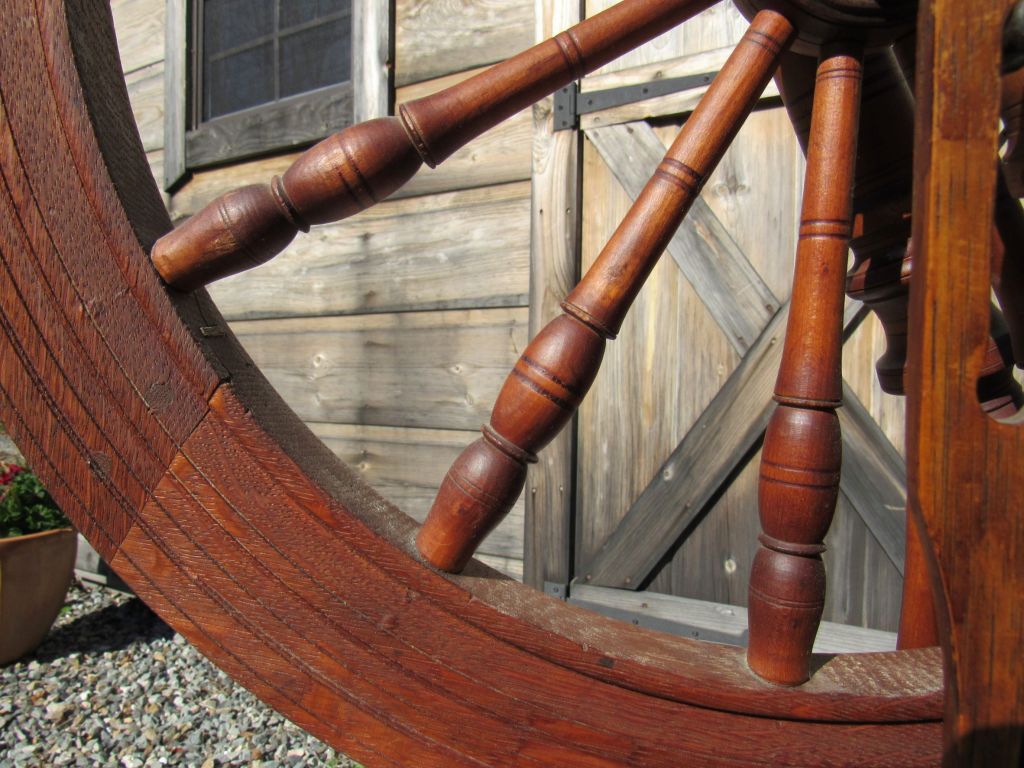

to the underside,

the materials, construction, and design are superb.

The wheels have a finely-finished quality,

exuberantly decorated with brilliant orange painted bands,

contrasted with black bands.


The feet are elegantly pointed
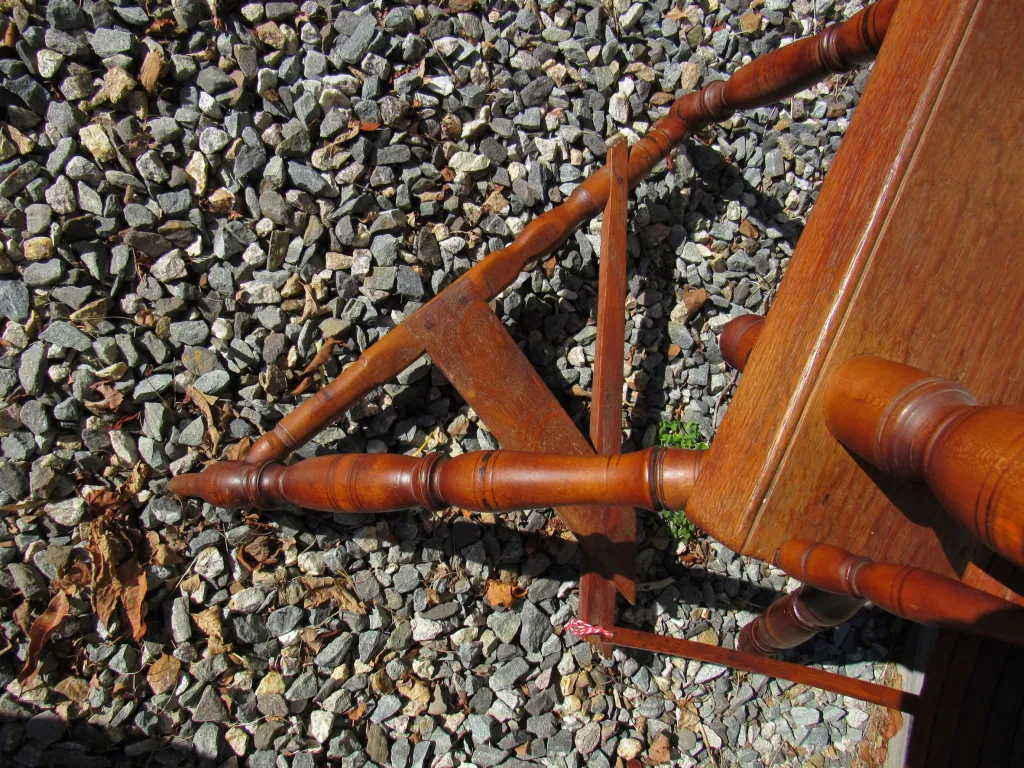
and the small-large-small chip carving on the table end gives a special touch.

His attention to the smallest details is remarkable.

Even the ends of the treadle bars have chip carvings.

The distaff arm is pegged in place to keep the distaff from flopping over when in use.

And the under-table portion of the wheel uprights are turned, beautifying a largely hidden part of the wheel–an unusual feature that makes him and his wheels stand out.

This wheel has seen some significant use,

with obvious wear on the treadle

and dent marks on the table.

Such marks have been the cause of much discussion in online antique wheel groups. They are often seen on Scandinavian wheels and the general consensus seems to be that small knives or other utensils were spiked into the table under the drive band to help guide or separate it, although often the marks do not look big enough to hold a knife upright for long.
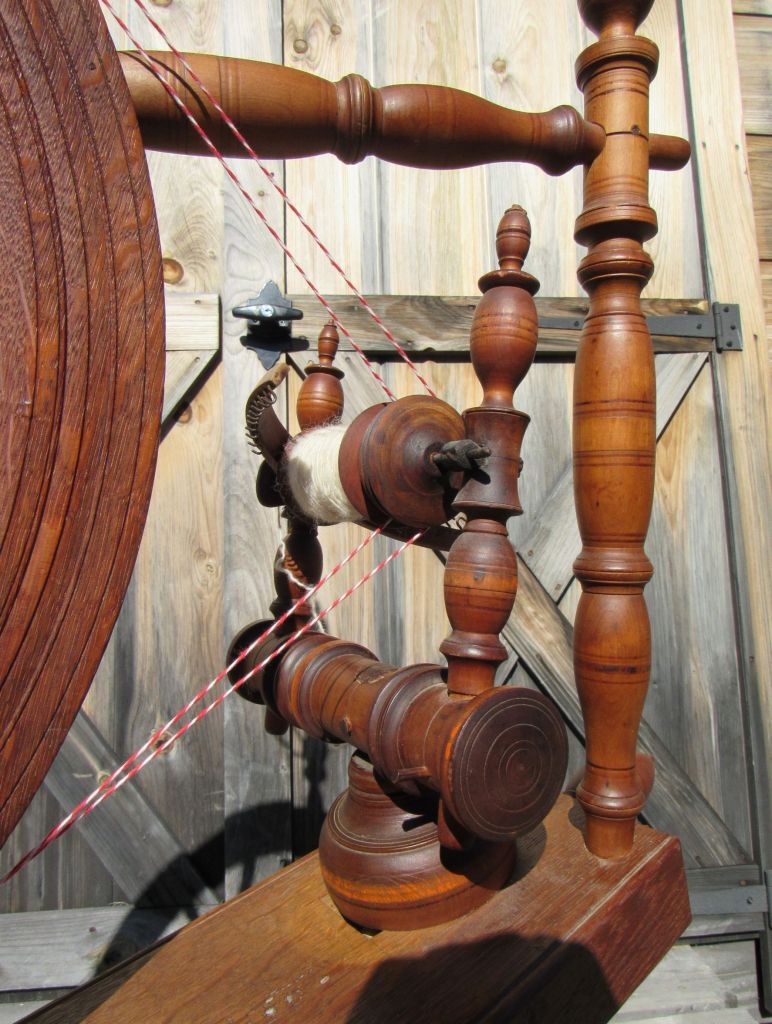
The flyer fits well and matches the wheel. It has some wear

but is in overall good condition with a smooth orifice

and a moderate wingspan (not as wide as many Pennsylvania flyers). It could be original, or not.

The distaff appears to match the wheel, but, again, I do not know if it is original.

Since Ester has Fox’s early stamp, we know the wheel was made before 1839, and this distaff looks as if it might be newer than that.

The footman is intriguing because it is elegantly curved. But, without seeing other similar Fox footmen, I doubt if it is original.

As for the date carved crudely carved under Fox’s mark, it appears to have originally been 1770 and then changed to 1880.

Both dates are puzzling, because Fox would have been 15 in 1770 and dead in 1880. Still, it is part of the wheel’s history and mystery.

This wheel is a testament to the power of material things and the importance of preserving them. While there seem to be few written details about Jacob Fox, his branding iron and his wheels give us clues about him and his life. He lives on in them.

January 6, 2023 edited to add:
After posting this, I heard from two owners of J. Fox wheels, both of whom confirmed that Ester’s distaff is consistent with others on Fox wheels and likely original. In addition, Bill Leinbach sent this photo of Fox reeling pin (thanks Bill):
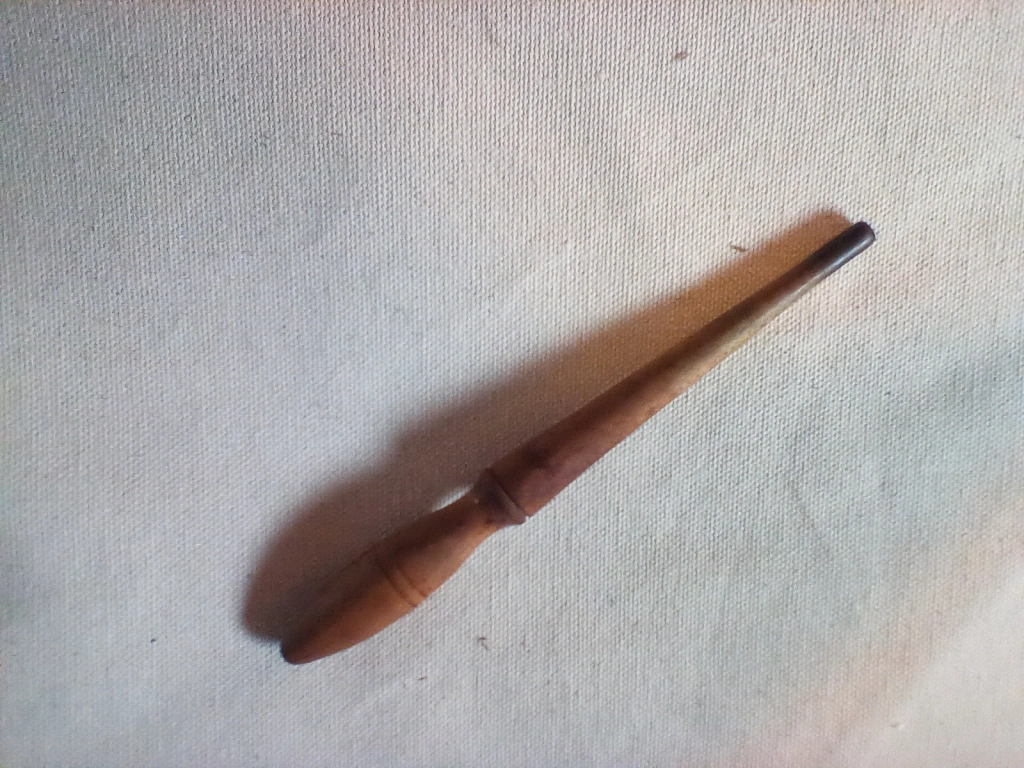
References:
Taylor, Michael, “Reeling Pins,” The Spinning Wheel Sleuth, Issue #115, January 2022, pp. 7-8
Bartlett, Louisa, Curator, A Cultural Celebration: Arts of the Berks County Pennsylvania Germans From a Private Collection, paper available online from exhibit June 12-Sept. 26, 2010, pp. 28-29.
Goyne Evans, Nancy, American Windsor Furniture, Specialized Forms, Hudson Hills Press, New York, N.Y. 1997.
Goyne Evans, Nancy, Windsor-Chair Making in America, From Craft Shop to Consumer, University Press of New England, Lebanon, N.H. 2006. Fox’s dated brand is pictured on page 80.
Pennington, David and Taylor, Michael, Spinning Wheels and Accessories, Schiffer Publishing, Atglen, PA 2004, pp. For a wonderful discussion of eastern Pennsylvania wheels see Chapter 11, pp. 123-29.
ancestry.com for genealogical research

Having encountered “elegantly curved” footmen exactly like this, which were quite simply warped wood, I agree that this one probably is *not* original. Mr. Fox would likely have used fully seasoned wood in the first place. And footmen wear out, and regularly need replacing.
LikeLike
Ha. Should we now use “elegantly curved” as a euphemism for warped? In this case, however, the grain (and the length) indicates that the footman was deliberately cut in a curve rather than warped. Interestingly, I do have an internal crank wheel that requires a curved footman but there’s no reason for a curve in this one, that I can see, other than esthetics. Absent evidence that Fox did this on other wheels, I suspect the woodworker replacing the footman wanted to make a distinctive footman. And it does look good with the wheel. Good to hear from you David.
LikeLike
I am always fascinated by the structure of these wheels and the lives of the makers. Imagine certain wheels and accoutrements for them were fashionable or functional at one time. And the wood is always beautiful. So yes, I can imagine an elegant curve being added…
LikeLike
It is amazing how quickly we lose knowledge about the day-to-day details of life. For all the women who spun for decades in this country, we know very little about how they spun, how and why wheel styles changed, and what tools they used to make their work easier or more efficient. All this basic knowledge that was passed down orally but was not considered worth writing down. It has been lost in a very short amount of time. Makes the wheels all the more fascinating though, for the clues they give us.
LikeLike
I have a book that belonged to my maternal grandfather called How To Do Things. I wonder if there’s anything about spinning in it–it does have things women would do as well. I’m going to check. It was published in the late 19th C., so there may have been enough commercial mills by that time for wool and fabric, but I’ll let you know what I find. Generally, historians have not been interested in household things or women’s work or even women’s contributions to ideas. Emerson was greatly influenced by his aunt Mary Moody Emerson, for example and it took a biography by Robert Richardson for me to find that out–long after grad school was over…
LikeLike
Now you have me interested in Mary Moody Emerson! I used to live two towns away from Concord, and did a lot of reading then about the Transcendentalists. I don’t recall hearing about Mary, though, so I’m looking forward to reading her letters and journals (just ordered a copy from the library). Thanks for introducing her to me. I love that her final home, which she apparently loved deeply, was a farm in Maine.
LikeLike
This is so cool! I’m glad your local library can get the collected writing for you. I wonder if the farm still exists as a spot that one can visit…
LikeLike
I haven’t been able to find if the farmhouse is still standing. Also, the farm wasn’t her “final” home, as I thought, she, along with her sister, lived there off and on for years. It will be fun to do more research. As for her writings, through our local library, I have access to every library in Maine–it’s a wonderful statewide system. I’m often amazed at what I can find!
LikeLike
Turns out the book was published in 1919. A lot of interesting household information, but nothing on spinning. I think by the end of WWI most people were buying fabric, alas.
LikeLike
Thanks for looking! Women in Quebec were still spinning in 1919, but most spinning wheels in this country had long been relegated to the attic or barn by then. And, yes, the fact that spinning wheels were almost entirely women’s tools has been a factor in the general lack of respect for them as an important part of our material culture.
LikeLike
The photo showing the turned bases of the uprights beneath the table also shows scribing lines used to orient the drilled angles of the two leg sockets.
LikeLike
Yes! I should have mentioned the scribe lines.
LikeLike